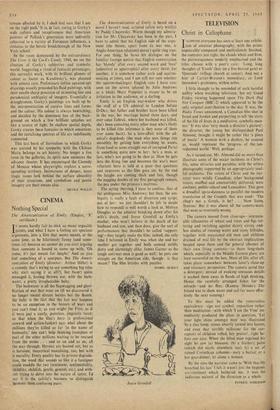I SUPPOSE everyone has seen at least one exhibi- tion of
amateur photography, with the prints impeccably composed and meticulously finished, the contrasts just right, the clouds white and firm, the picturesqueness tenderly emphasised and the titles chosen with a poet's care: 'Long, long thoughts of Youth' (boy on a five-barred gate) or 'Quietude' (village church at sunset). And not a hint of Cartier-Bresson's immediacy, or Lord
Snowdon's graininess, within miles. ,
I little thought to be reminded of such tasteful nullity when watching television, but my Good Friday viewing happened upon The Dark Did Not Conquer (BBC-2) which appeared to be the only original contribution to the day. It was, the Radio Times announced, a Canadian film shot in Israel and Jordan and purporting to tell 'the story of the life of Jesus in a meditative, symbolic man- ner.' It was also 'very much a director's picture'; the director, the young but distinguished Paul Almond, thought it might be rather like 'a piece of music.' A woman with a donkey, he assured us, would represent the 'progress of the ,un- redeemed world.' Well, perhaps....
As it turned out, Mr. Almond did no more than illustrate some of the major incidents in Christ's life, some miracles and parables, with the artiest photography supported by an appropriately soul- ful orchestra. The voices of Christ and the nar- rator were mildly Canadian; other background voices, muffled and amateurishly delivered, were cockney, public-school and Lancashire. This gave a dreadful up-to-dateness to parallel the modern translation of the Gospels that was used: 'The chap's not a Greek, is he? . . . Now listen, Stavros.' But it was above all the camera-work that went so reverently wrong.
The camera moved from close-ups—intermin- able silhouettes of wheat and vines and figs tot- tering and twitching against dainty cirrus, end- less studies of running water and stony hillsides, together with occasional old men and children drained of real life by the abstract implications heaped upon them and the general absence of their own living contexts—to those long-shots which, especially in the Middle Eastern glare, are least successful on the box. Most of life, after all, takes place somewhere between lover's close-up and visionary perspective. The camera acted like a detergent; instead of evoking sensuous details it washed them away in floods of high thinking. Hence the carefully arranged fishes for the miracle—and no flies. (Kaneto .Shindo's The Island was to show water and soil far more effec- tively the next evening.) To this must be added the remorseless equivalence --sign not symbol, exposition rather than meditation—with which 'I am the Vine' im- mediately produced the plant in question, 'Let your light shine amongst men' was illustrated by a clay lamp, stones smartly turned into loaves, and even that terrible millstone for the cor- ruptors of children rolled, hey presto!, right be- fore our eyes. When the blind man regained his sight he saw (a) blossom, (b) a feathery palm (which did nicely elsewhere too), (c) a set of ruined Corinthian columns—nary a bazaar or a hot goat-dinner, let alone a woman.
By the time the narrator came to 'With that He breathed his last' I felt it wasn't just the hygienic art-treatment which bothered me, it was the ludicrous naivete of the direction, as a whole.
PATRICK ANDERSON






























 Previous page
Previous page